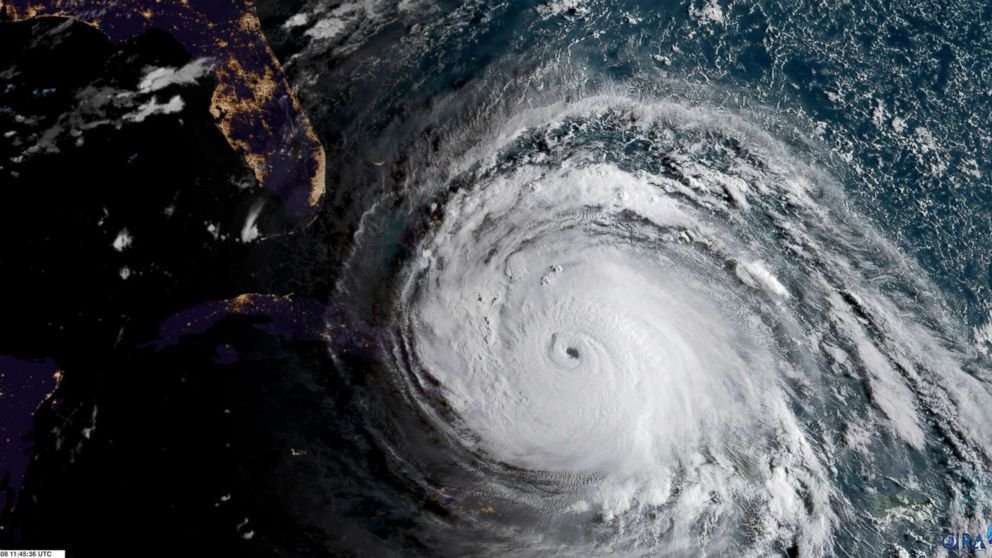Hurricane Irma, the most powerful Atlantic storm in a decade, hit Cuba overnight as a rare Category 5 storm, then shifted course toward the west coast of Florida.
The monster storm's shift in direction creates a "very, very dangerous situation for western Florida," said ABC News meteorologist Daniel Manzo.
As of 8 a.m. Saturday morning, Irma was a Category 4 with maximum sustained winds of 130 mph. It was about 225 miles from Miami, moving west-northwest at 12 mph.
Naples, Fort Myers and other communities on Florida's west coast could get slammed when Irma makes landfall as a Category 4 storm, which is expected to happen between early Sunday and early Monday. Landfall could occur as far north as Tampa.
The wind gusts in Florida were already picking up early Saturday, with Miami International Airport reporting a 59 mph gust.
Power outages, halted flights and empty ATMs in Florida
Florida's governor said 25,000 power outages were reported as of Saturday morning.
Florida alone should anticipate days-long power outages, FEMA said.
Ahead of Irma's arrival in the Sunshine State, the last flights departed Friday night from Miami International Airport and Fort Lauderdale-Hollywood International Airport. Miami's airport officially remains open, while Fort Lauderdale's airport is closed for Saturday and Sunday.
Many ATM machines across southwest Florida were out of cash by late Friday night after people stocked up in case Hurricane Irma causes power outages that make debit and credit card transactions impossible, The Associated Press reported.
"This is as real as it gets," the National Weather Service in Key West tweeted Friday evening.
***THIS IS AS REAL AS IT GETS*** ***NOWHERE IN THE FLORIDA KEYS WILL BE SAFE*** ***YOU STILL HAVE TIME TO EVACUATE*** Please RT. #Irma pic.twitter.com/VWLMEDWoUs — NWS Key West (@NWSKeyWest) September 8, 2017
The National Hurricane Center on Friday cautioned that Irma, which then had maximum sustained winds of 155 mph, is "extremely dangerous," strong enough to uproot trees, bring down power poles and rip off the roofs and some exterior walls of well-built frame homes.
"Obviously Hurricane Irma continues to be a threat that is going to devastate the United States," Brock Long, administrator of the Federal Emergency Management Agency (FEMA), said at a press conference Friday morning. "We're going to have a couple rough days."
Rainfall accumulations in southeast Florida and the Florida Keys are expected to reach 10 to 15 inches, with totals up to 20 inches locally. Eastern Florida up the coast to Georgia is expected to receive 8 to 12 inches, according to the National Hurricane Center.
Millions evacuate; many others take shelter
Approximately 5.6 million Floridians have either been ordered to evacuate or advised to leave voluntarily, the Florida Division of Emergency Management told ABC News late Friday night. When evacuation orders in South Carolina and Georgia are included, the number exceeds six million.
Georgia Gov. Nathan Deal declared a state of emergency for 94 counties in his state, and South Carolina Gov. Henry McMaster issued mandatory evacuations for barrier islands in Colleton, Beaufort and Jasper.
There are facilities to shelter one million people in Florida, a FEMA spokesperson told ABC News, although there was a question whether there is enough staffing to serve all of those in shelters.
More people are expected to go to shelters on Florida's west coast, where some are already at capacity, Gov. Rick Scott said in a press conference Friday night.
More shelters are opening in Lee County in the Fort Myers area -- and in Collier County, in the Naples area, Scott said.
Palm Beach County has issued a curfew to prevent looting and other criminal activity as the storm approaches, according to a press release. The curfew goes into effect Saturday at 3 p.m. It is unclear when it will be lifted.
Irma turns to U.S. after pummeling the Caribbean leaving at least 20 dead
At least 20 people have died and thousands were left homeless after Irma battered a string of Caribbean islands on Wednesday, according to the AP. At the time, Irma was a Category 5 hurricane with maximum sustained winds of 185 mph.
Dutch Defense Ministry via AFP/Getty Images
Netherlands Ministry of Defense via Reuters
At least three people died from the storm in the U.S. territory of Puerto Rico.
The Turks and Caicos islands were hit hard as Irma passed over the tiny archipelago in the Atlantic Ocean. A government spokesperson told ABC News the British overseas territory had sustained "catastrophic" damage.
The National Hurricane Center warned of a storm surge up to 20 feet on Turks and Caicos with 8 to 12 inches of rain for the low-lying islands through Sunday.
Long, the FEMA administrator, said Friday that the agency's primary goal is to "stabilize the Virgin Islands and Puerto Rico" by restoring power, maintaining security and bringing in life-sustaining supplies.
ABC News' Daniel Peck and Max Golembo contributed to this report.

consumedbythefire on September 9th, 2017 at 05:18 UTC »
Here's a collection of live streams from areas that will be affected
Kungfumantis on September 9th, 2017 at 01:36 UTC »
Last cat 5 to directly hit the keys was the Labor Day Hurricane back in the 30s. It caused massive damage and a huge loss of life, they were fishing bodies out of the water all along the gulf coast for months after the storm.
kalel1980 on September 8th, 2017 at 22:33 UTC »
I heard this morning it was down to a cat 4. Did it pick up strength back to a 5?!